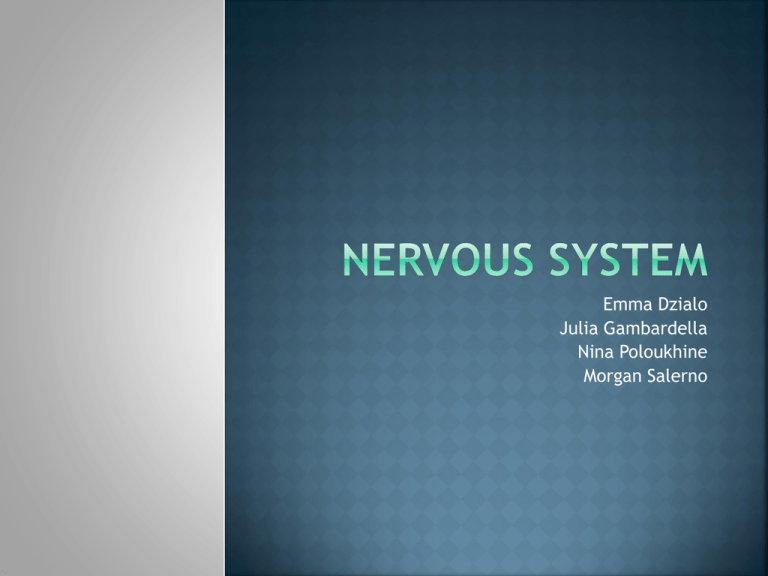Nervous system
advertisement

Emma Dzialo Julia Gambardella Nina Poloukhine Morgan Salerno http://www.youtube.com/watch?v=sjyI4CmB OA0&safe=active The nervous system is a network of nerve cells and fibers that transmit nerve impulses between parts of the body. 2 main types of nervous systems Central(CNS)- brain and spinal cord Peripheral(PNS)- nervous of brain and spine Somatic- controls voluntary activity (ie. Activation of muscles) Autonomic- controls involuntary activity (ie. Heart contraction and homeostasis) Neuroglia- support, insulate and protect neurons Neurons- send electrical messages throughout body Synapse- point of contact between neurons Stimuli- Changes that effect nervous system Neurotransmitters- chemicals that stimulate neurons, muscles or glands Neuron Dendrite(s)- sends neurotransmitters toward body Axon(s)- sends neurotransmitters away from body Soma(Cell Body)- location of nucleolus in a neuron End Terminal- a.k.a where Synapse occur Surrounds the axon essential for proper functioning of the nervous system Effect of a damaged myelin is Multiple Sclerosis https://www.youtube.com/watch?v=i- NgGKSNiNw 1. 2. 3. 4. Neurotransmitters are released from pre-synaptic cell’s vesicle and travel down axon. The chemicals are released out of the neuron’s terminal end and into the synapse. The dendrites of post-synaptic neuron take the neurotransmitter molecules through receptor binding. The excess chemicals in the synapse are taken back by the pre-synaptic neuron through the re-uptake inhibitor. FX: takes in sensory information and responds accordingly Made up of brain and spinal cord Spinal Cord- responsible for transporting information (protected by vertebral column) Brain- consciously and unconsciously coordinates bodily function in response to information it has received (protected by cranium) Tract- bundle of nerve processes in CNS Efferent Neuron- conducts impulses to muscle and glands (away from CNS) Afferent Neuron- conducts impulses toward CNS from the body Ganglia- collection of nerve cell bodies outside CNS Grey matter- areas dominated with cell bodies, dendrites and synapses FX: to process and generate signals White matter- areas dominated by axons Connects different areas of grey matter in brain and spinal cord FX: transmit nerve signals Neurons- responsible for sending and receiving nerve impulses Glial cells- non neuronal cells which provide support, nutrition, maintain homeostasis, and facilitate signal transmission glial cells outnumber neurons in the brain 50:1 Controls functions of all organs in the body, thoughts, memory, speech, movement, stress responses, etc. Three layers of tissue to cover and protect the brain and spinal cord Dura Mater Arachnoid Pia Mater Hypothalamus- contains nerve connections to pituitary gland Controls: eating, sexual behavior, regluates sleeping, body temp, emotions Thalamus- pain sensation, attention, and alertness Amygdala- controls feelings of fear and aggressive behavior Hippocampus- ability to remember new information Gland located behind the nose Controls secretion of hormones which regulates: growth/development FX: various body organs kidneys, ovaries, testicles, ect. FX: other glands thyroid, gonads, adrenal glands Produced in ventricles (hollow channels) of brain Clear, watery substance that helps to cushion the brain and spinal cord from injury Circulates through channels of the brain and spinal cord Frontal Lobe- largest of four lobes found in the front of the brain controls voluntary movements: speech, intellectual and behavioral functions, concentration, temper and personality Occipital Lobe- found in the back brain receives and processes images, depth perception, colors and shapes Parietal Lobe- top of brain a person’s memory and sensory info is received, vision, hearing, and meaning is given to objects Temporal Lobes- found behind the left and right ears Right temporal lobe responsible for visual memory, recognizing faces and objects Left temporal lobe responsible for verbal memory, remembering and understanding language, interprets emotions and reactions Cerebrum- made up of grey matter and is responsible for communication between different parts of the brain Cerebellum- located at the back of the brain controls fine tunes in motor movements, maintains posture, senses of balance and equilibrium Lower extension of brain(attaches the brain to spinal cord) Three parts of brainstem: Midbrain- center for ocular motion Pons- involved in coordinating eye and facial movements, facial sensation, hearing, balance Medulla Oblongata- controls breathing, blood pressure, heart rhythms, and swallowing Olfactory- smell Optic- visual fields; ability to see Oculomotor- eye movements, eyelid openings Trochlear- eye movements Trigeminal- facial sensations Abducens- eye movements Facial- eyelid closing, facial expression, taste sensation Auditory- hearing, sense of balance Glossopharyngeal- taste sensation and swallowing Vagus- swallowing and taste sensation Accessory- controls neck and shoulder movements Hypoglossal- tongue movement “highway to the brain” Length (average): Men: 45 cm Women: 43 cm Sensory nerves detect touch and send the nerve impulses to spinal cord then to brain Part of nervous system outside brain and spinal cord Made up of nerve fibers that travel to different parts of body FX: communicator between CNS (brain and spinal cord) to rest of the body Somatic- controls skeletal muscles and external sensory organs (skin) Voluntary (can be consciously controlled) Autonomic- controls involuntary muscles (smooth and cardiac muscles) Parasympathetic- controls activity that increase energy (ex. Constricting pupils, contracting bladder) Sympathetic- controls activity that conserve energy (ex. Speed of heart rate, dilating pupils, relaxing bladder) Meningitis: inflammation of the covering od brain and spinal cord Causes: headaches and neck stiffness Deadly if not treated Epilepsy: abnormal electrical impulses in the brain Can result in seizures Paralysis: caused by damage to spinal cord Carpal tunnel syndrome: caused from excessive pressure on median nerve (in wrist) Causes numbness, tingling and muscle damage in hands Common from typing on a computer Amyotrophic lateral sclerosis: progressive degeneration of motor neurons Causes progressive weakness of limbs, facial and respiratory muscles http://www.livescience.com/22665-nervous-system.html http://quizlet.com/36375426/the-nervous-system-flash-cards/ https://faculty.washington.edu/chudler/spinal.html http://en.wikipedia.org/wiki/Myelin http://www.innerbody.com/image/nervov.html http://www.livescience.com/22665-nervous-system.html http://learnzoology.wordpress.com/tag/neuron-tissue/ http://en.wikipedia.org/wiki/Peripheral_nervous_system http://users.rcn.com/jkimball.ma.ultranet/BiologyPages/P/PNS.html http://emedicine.medscape.com/article/1948687-overview https://faculty.washington.edu/chudler/nsdivide.html http://www.nlm.nih.gov/medlineplus/peripheralnervedisorders.html http://www.webmd.com/brain/default.htm?names-dropdown= http://uhealthsystem.com/health-library/neuro/disorder http://www.ninds.nih.gov/disorders/carpal_tunnel/detail_carpal_tunnel.htm http://www.alsa.org/about-als/what-is-als.html http://faculty.stcc.edu/AandP/AP/AP1pages/nervssys/unit10/division.htm








